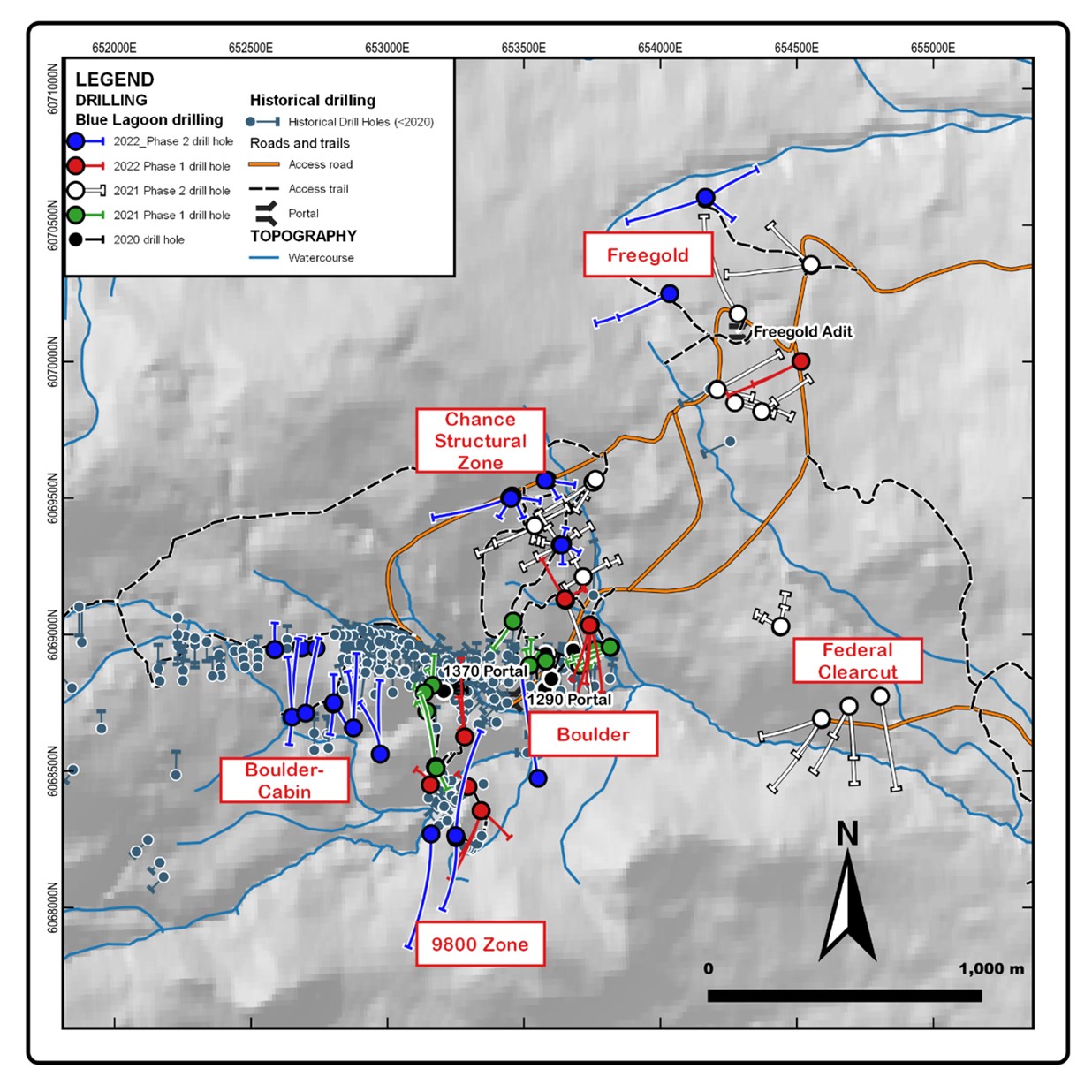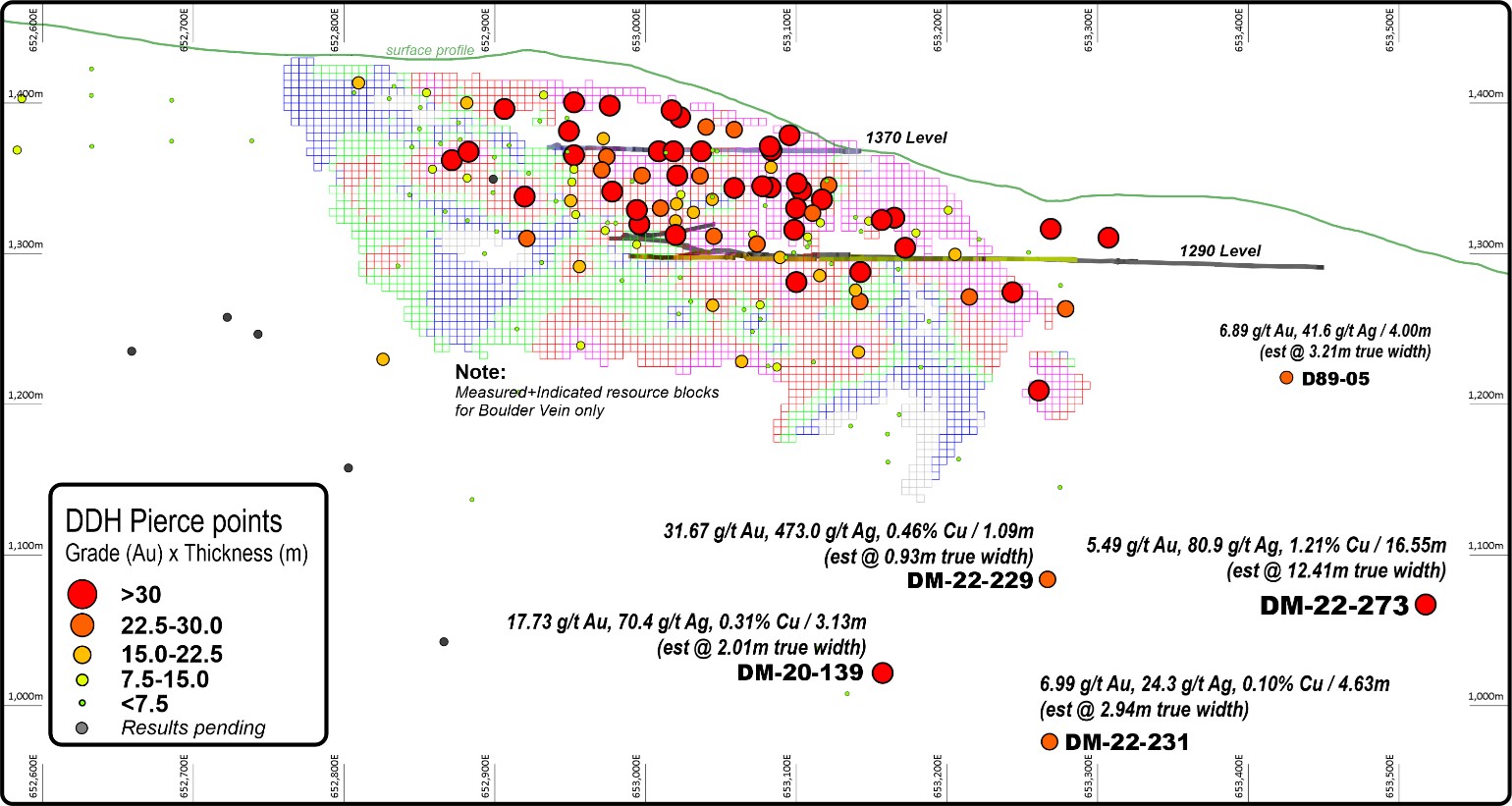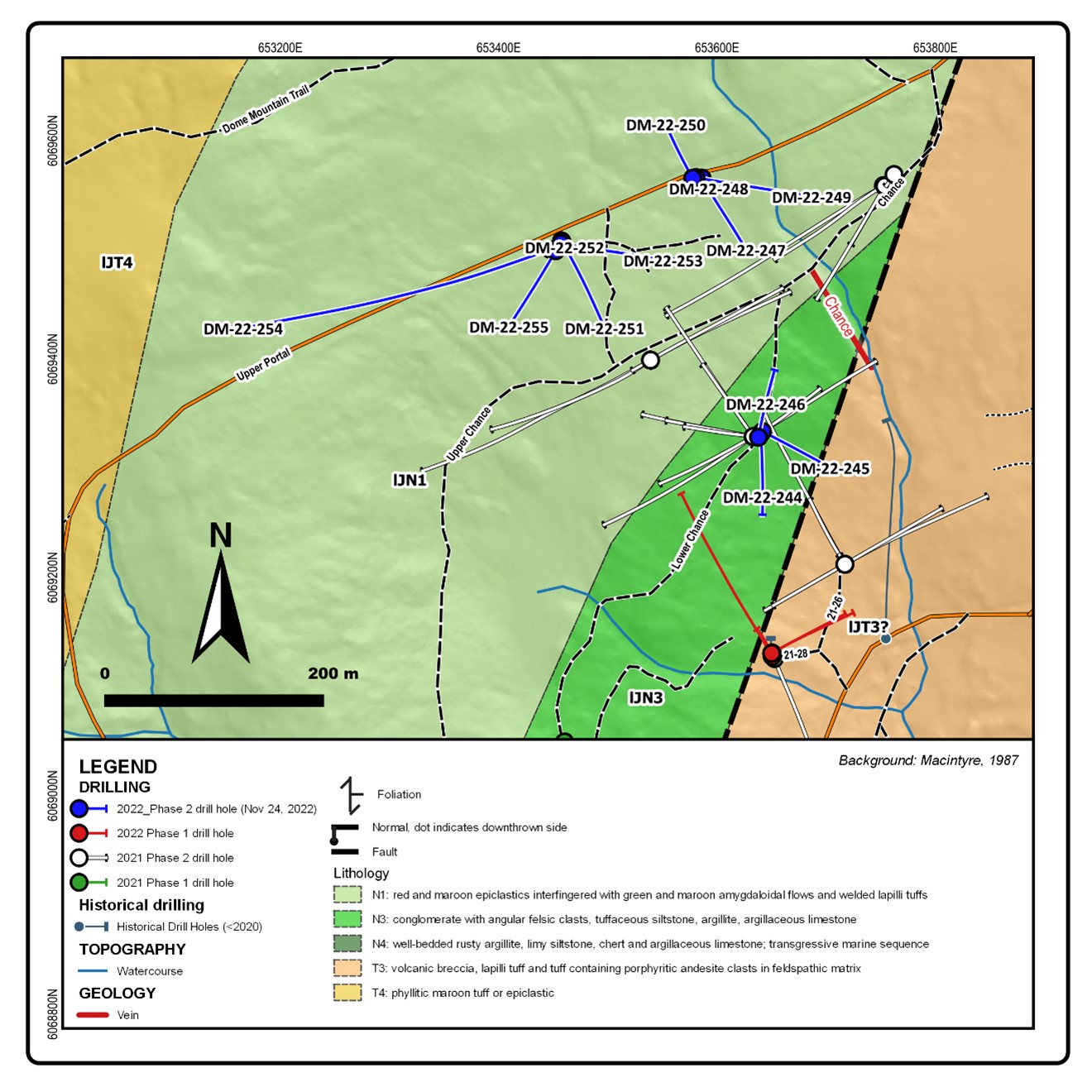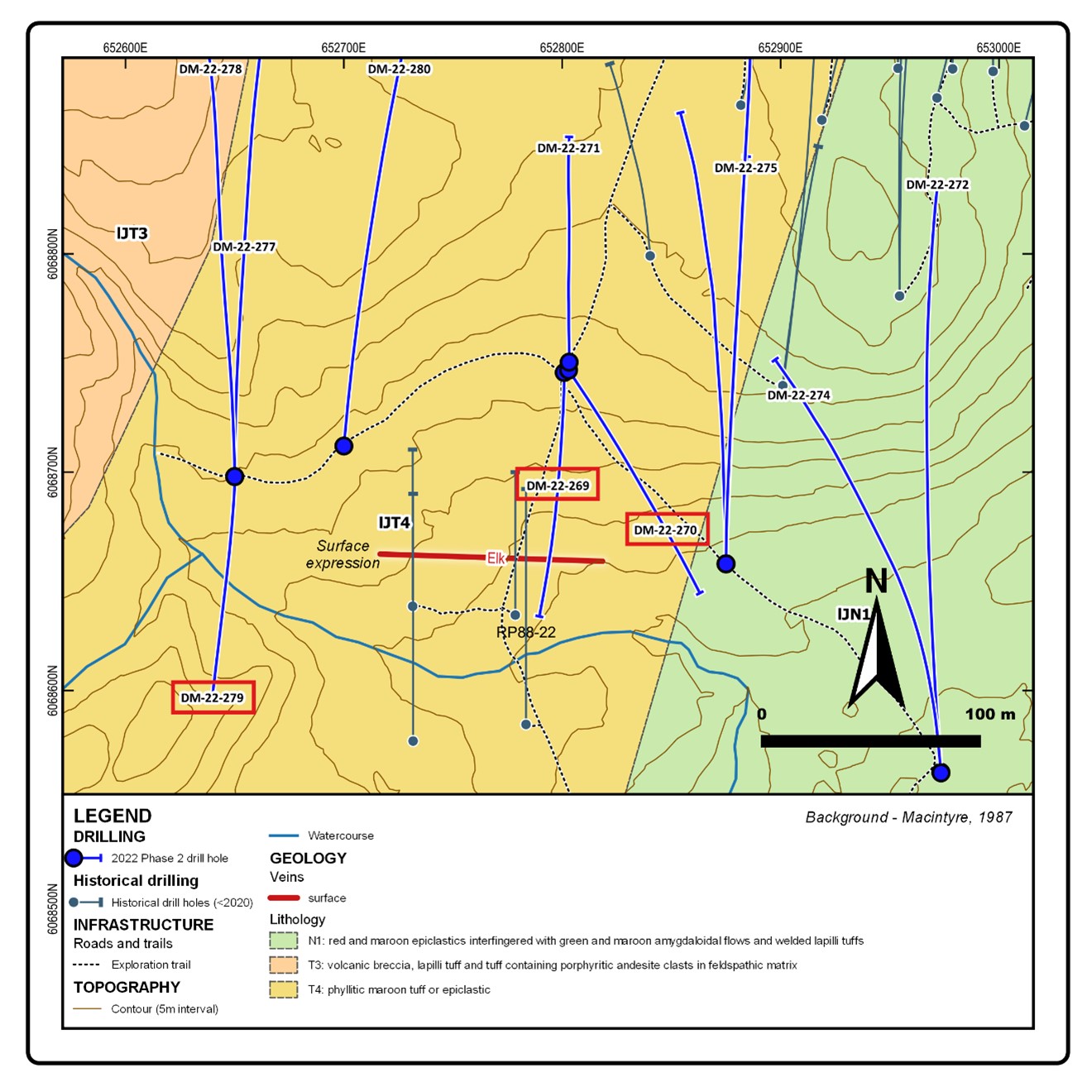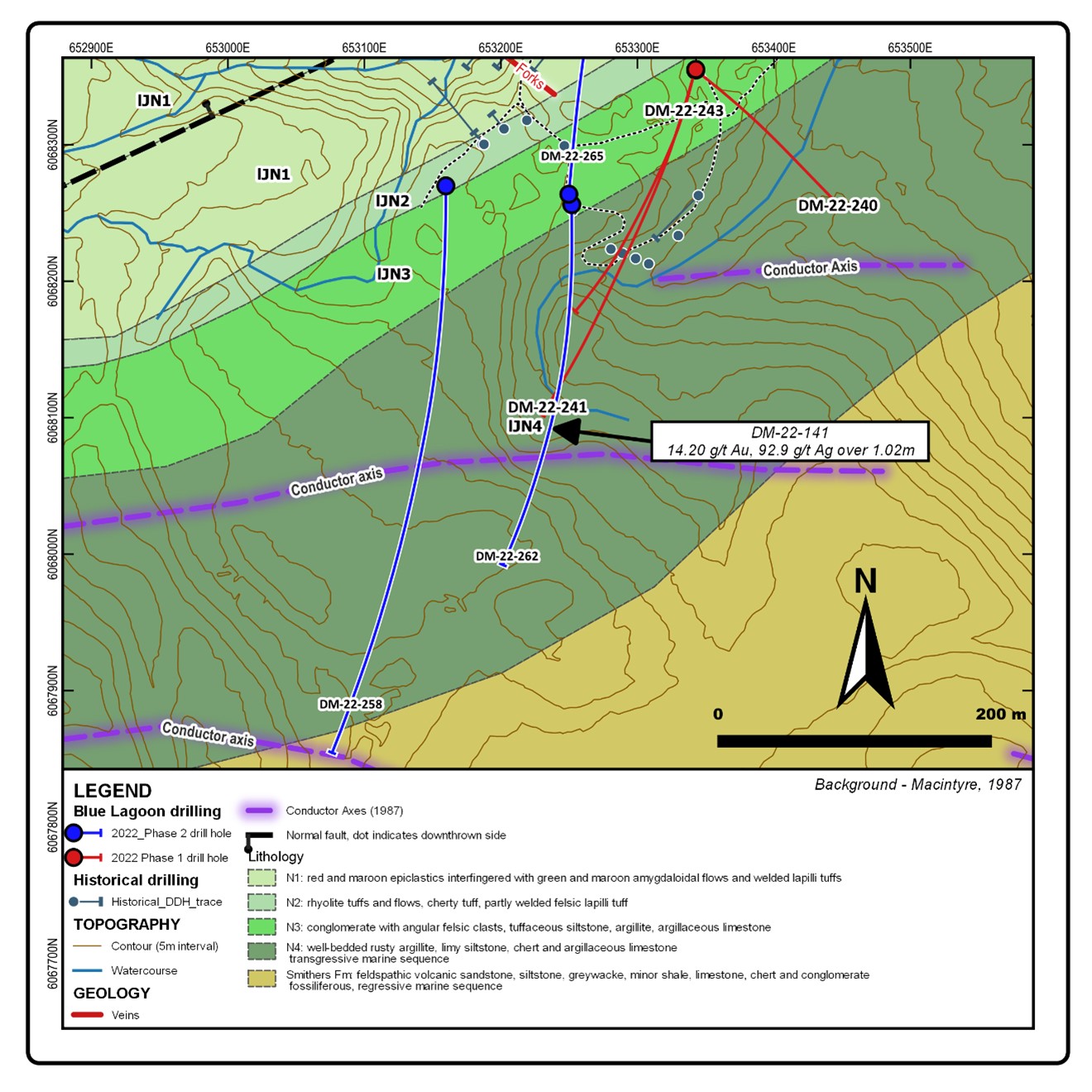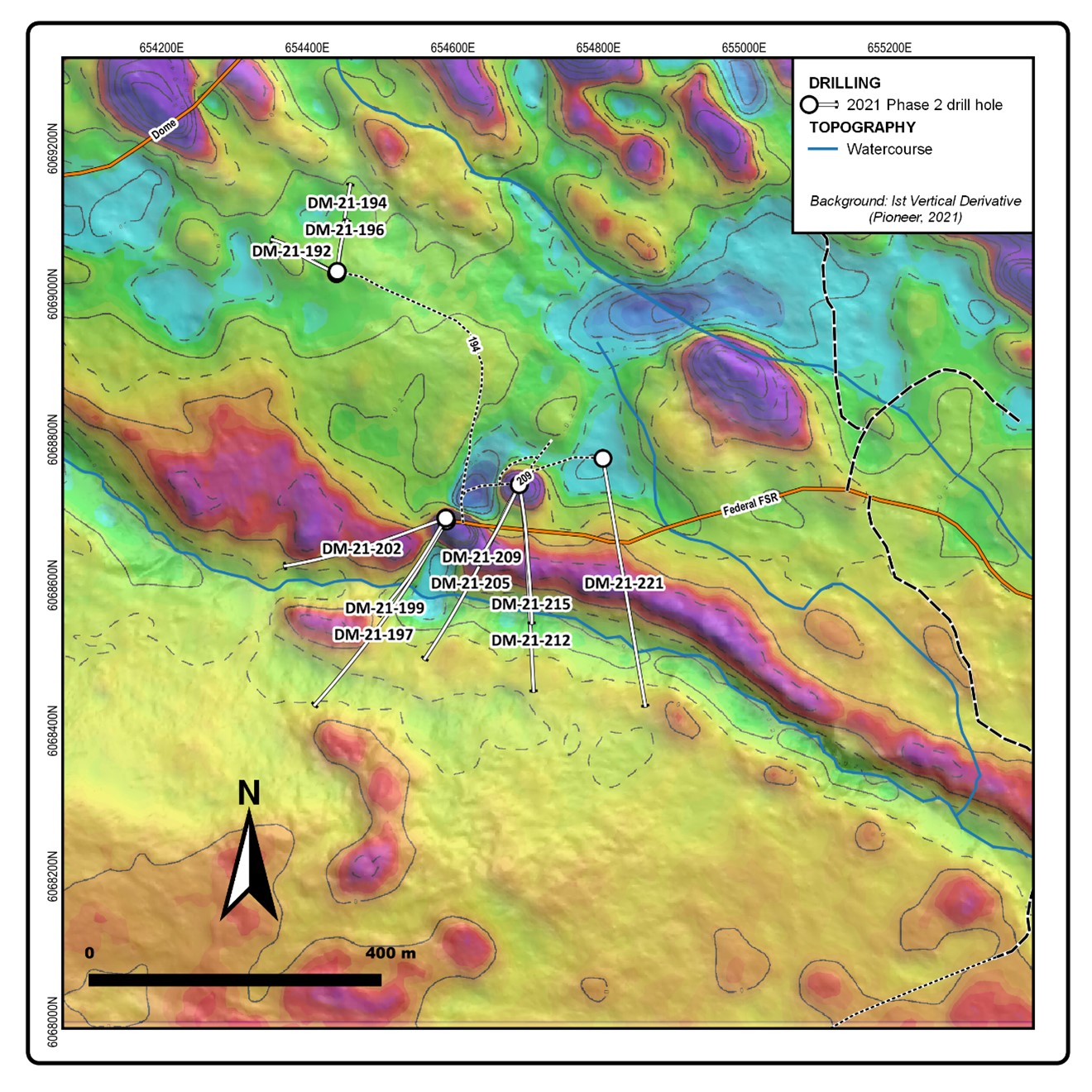Blue Lagoon Encounters 11.02 gpt Au and 2.31% Cu Over 5.65 Meters within 5.49 gpt Au and 1.21% Cu Over 16.55 Meters in a Major Step-Out Hole on the Boulder Vein

- This intercept adds 250 meters of strike length to a previous deep intercept that is 200 meters below current resource
- The vein system appears to become Au-Cu-rich to the east and at depth
Blue Lagoon Resources Inc. (the “Company“) (CSE:BLLG) (FSE:7BL) (OTCQB:BLAGF) is pleased to announce significant mineralized intercepts from the last of the 2022 Phase Two drill holes on its all year-round and road accessible Dome Mountain Gold Project, located a short 50-minute drive from Smithers, British Columbia. Drill results from diamond drill hole DM-22-273, a major step-out hole, include:
- 11.02 g/t Au, 115.8 g/t Ag and 2.31% Cu over 5.65 meters within
- 5.49 g/t Au, 80.9 g/t Ag and 1.21% Cu over 16.55 meters from the Boulder Vein.
Hole DM-22-273 is an aggressive step-out hole that tested continuation of mineralization in the Boulder Vein 200 meters below surface and 250 meters along strike to the east of previous deep intercepts (DM-22-229, -231) (Figure 2). The altered and mineralized intercept, encountered at a down hole depth of approximately 285 meters depth and persisting over 25 meters, is interpreted to be the structural zone hosting the Boulder Vein. The most recent modelling (2021) of the Boulder Vein did not extend this far east.
Significant mineralization within this zone extended over 16.55 meters returning 5.49 g/t Au, 80.9 g/t Ag and 1.21% Cu beginning at 291.45 meters and included a higher grade subinterval of 5.65 meters returning 11.02 gpt Au, 115.8 gpt Ag and 2.31% Cu beginning at 302.35 meters. The former intercept is the thickest mineralized core intercept across the Boulder Vein out of over 40,000 meters of previous drilling. True width of the intercept has yet to be fully confirmed but is estimated at approximately 75% of core length, or 12.41 meters wide.
“The high-grade gold intercept in hole DM-22-273 is one of the best Blue Lagoon has encountered on the Boulder Vein System to date,” said Bill Cronk, Chief Geologist for Blue Lagoon. “The thickness of this mineralized zone, approximately 12.41 meters true width, is a game changer for us. At least an additional 250 meters of strike length is demonstrated by this intercept at depth. We expect that we will be able to add considerable tonnage to the vein as we pursue further drilling downdip and along strike. We currently have a drill rig located at the same collar location as hole DM-22-273 and will begin follow up drilling as part of our 2023 Phase One drill program scheduled to begin this week.”
Phase One drilling in 2023 is anticipated to encompass approximately 5,000 meters of diamond core drilling.
Table 1: Significant intersections (>1 g/t Au), drill hole DM-22-273
| Hole | Intersection | Grade | ||||||
| From | To | Length | Au (g/t) | Ag (g/t) | Cu (%) | Pb (%) | Zn (%) | |
| DM-22-273 | 267.80 | 268.45 | 0.65 | 7.72 | 13.3 | 0.074 | 0.005 | 0.043 |
| DM-22-273 | 291.45 | 308.00 | 16.55 | 5.49 | 80.9 | 1.212 | 0.015 | 0.283 |
| incl | 294.00 | 295.50 | 1.50 | 9.51 | 79.7 | 0.764 | 0.011 | 0.077 |
| and | 296.08 | 296.75 | 0.67 | 14.00 | 70.2 | 1.260 | 0.036 | 0.102 |
| and | 302.35 | 308.00 | 5.65 | 11.02 | 115.8 | 2.312 | 0.031 | 0.433 |
| DM-22-273 | 379.66 | 380.50 | 0.84 | 6.14 | 3.9 | 0.022 | 0.016 | 0.028 |
| DM-22-273 | 449.00 | 451.50 | 2.50 | 2.62 | 20.6 | 0.116 | 0.012 | 0.123 |
| incl | 450.50 | 451.50 | 1.00 | 4.78 | 44.7 | 0.253 | 0.021 | 0.075 |
The 2022 Phase 2 drill program totalled 41 drill holes totaling 12,327 meters (Figure 1).
Figure 1: 2022 Phase 2 drilling plan map
Figure 2: Schematic vertical long section, Boulder Vein. Pierce point to pierce point from hole DM-20-139 to DM-22-273 is 387 meters
Boulder-Cabin Vein surface sampling and drilling
Recent drilling conducted by Blue Lagoon on the Boulder-Cabin Vein (the western extension of the Boulder Vein in an area historically referred to as the Cabin Vein) (Figure 4), extends potential quartz-carbonate vein mineralization approximately 650 meters west of the current modelled resource. Historic trenching and drilling along this structure demonstrates that the mineralized structure hosting the known Boulder Vein resources does continue, however it was thought to be spotty and limited in gold grade. A surface dump of the vein material from historical trenching was also sampled during the 2022 work program. Randomized composite grab samples from eight stations across the dump returned gold grades ranging from 1.49 to 14.50 g/t Au and 34.7 to 376 g/t Ag along with significant copper, lead and zinc concentrations (Table 2). It is not known from what trench(es) this material was sourced and are only a demonstration of the expected grades from this area.
Table 2: Surface sampling, Cabin Vein dump
| Sample ID | Description | Au | Ag | As | Cu | Pb | Zn |
| ppb | ppm | ppm | ppm | ppm | ppm | ||
| 74755 | From Cabin Vein dump at Federal Creek crossing; White quartz with semi-massive clots of pyrite (40%), chalcopyrite within fractures and disseminated (<2%). Surface with strong orange Fe-oxide coating | 2220 | 89.1 | 465 | 2630 | 1470 | 4860 |
| 74756 | From Cabin Vein dump at Federal Creek crossing: White quartz with thin fracture filling sulfides – mostly pyrite but also unidentified grey sulphide or sulphosalt – likely some sphalerite and galena; overall 5-7% sulphide content | 3520 | 77.0 | 1090 | 5000 | 2.22% | 2.97% |
| 74759 | 1+00, randomized grad samples across dump; samples for testing overall grade of Cabin dump area | 1490 | 47.3 | 251 | 931 | 0.73% | 2610 |
| 74760 | 2+00, randomized grab samples across dump | 5440 | 92.0 | 306 | 2800 | 0.52% | 8000 |
| 74761 | 3+00, randomized grab samples across dump; with some wallrock | 11300 | 376.0 | 322 | 1.61% | 1.31% | 6050 |
| 74762 | 4+00, randomized grab samples across dump | 3040 | 213.0 | 686 | 8620 | 2.49% | 2.02% |
| 74763 | 7+00, randomized grab samples across dump | 3620 | 47.1 | 189 | 1230 | 1140 | 1950 |
| 74764 | 8+00, randomized grab samples across dump | 14500 | 137.0 | 366 | 3580 | 1.90% | 2.01% |
| 74765 | 9+00, randomized sample of fines from under coarse dump material | 4080 | 34.7 | 254 | 1140 | 2160 | 2670 |
| 74766 | 10+00, randomized grab samples across dump; with some wallrock | 2310 | 44.6 | 219 | 1450 | 0.88% | 8370 |
| 74767 | “Baseline”, randomized grab samples across dump; sample line approx. 075° | 6320 | 168.0 | 968 | 7250 | 1.02% | 1.03% |
Figure 3: Cabin Vein dump sampling
Partial results have been received for drill holes completed on the western extension of the Boulder Vein. Recent drilling targeted both near surface (50-100 meters) and at depth (up to 350 meters) in areas beyond the current resource model. Highlights from this area include shallow drill holes DM-22-263 (3.68 g/t Au and 37.4 g/t Ag over 6.44 meters and including 1.24 meters of 15.10 g/t Au and 103 g/t Ag) and DM-22-264 (7.76 g/t Au and 218.3 g/t Ag over 1.82 meters and including 0.89 meters of 13.80 g/t Au and 345 g/t Ag). Deeper drill holes thus far have demonstrated more spotty mineralization in the expected zones of mineralization. However, drill results from this area are still outstanding at this time.
Figure 4: Boulder-Cabin and Elk Vein Drilling
Table 3: Additional significant intercepts, Boulder Vein drilling (>1 g/t Au)
| Hole | Intersection (m) | Grade | ||||||
| From | To | Length | Au (g/t) | Ag (g/t) | Cu (%) | Pb (%) | Zn (%) | |
| DM-22-263 | 8.00 | 8.53 | 0.53 | 5.35 | 4.2 | 0.262 | 0.006 | 0.003 |
| DM-22-263 | 86.36 | 92.80 | 6.44 | 3.68 | 37.4 | 0.218 | 0.141 | 0.306 |
| incl | 86.36 | 87.60 | 1.24 | 15.10 | 103.0 | 0.600 | 0.291 | 0.262 |
| DM-22-263 | 118.60 | 121.45 | 2.85 | 1.20 | 8.8 | 0.227 | 0.043 | 0.114 |
| incl | 121.20 | 121.45 | 0.25 | 7.71 | 22.3 | 0.136 | 0.432 | 0.447 |
| DM-22-263 | 132.00 | 132.50 | 0.50 | 3.65 | 119.0 | 1.290 | 0.153 | 0.298 |
| DM-22-264 | 68.26 | 70.08 | 1.82 | 7.76 | 218.3 | 0.858 | 0.677 | 1.013 |
| incl | 68.26 | 69.15 | 0.89 | 13.80 | 345.0 | 1.150 | 0.900 | 0.223 |
| DM-22-265 | Results pending | |||||||
| DM-22-266 | 90.15 | 90.50 | 0.35 | 3.46 | 51.2 | 0.432 | 0.035 | 0.008 |
| DM-22-267 | 45.12 | 46.02 | 0.90 | 2.88 | 29.6 | 0.337 | 0.108 | 0.295 |
| DM-22-267 | 47.82 | 50.64 | 2.82 | 2.64 | 29.4 | 0.308 | 0.220 | 0.299 |
| DM-22-268 | 58.00 | 59.00 | 1.00 | 1.24 | 7.5 | 0.038 | 0.238 | 0.282 |
| DM-22-271 | Results pending | |||||||
| DM-22-272 | Results pending | |||||||
| DM-22-274 | 166.38 | 167.50 | 1.12 | 6.95 | 18.6 | 0.153 | 0.059 | 0.283 |
| incl | 166.38 | 166.75 | 0.37 | 15.50 | 40.6 | 0.317 | 0.112 | 0.702 |
| DM-22-274 | 329.35 | 329.93 | 0.58 | 1.74 | 11.2 | 0.128 | 0.025 | 0.026 |
| DM-22-274 | 361.34 | 361.95 | 0.61 | 3.05 | 28.2 | 0.506 | 0.135 | 0.189 |
| DM-22-274 | 410.5 | 411.23 | 0.73 | 1.96 | 12.2 | 0.069 | 0.048 | 0.102 |
| DM-22-274 | 472.5 | 473.00 | 0.5 | 1.51 | 1.0 | 0.006 | 0.002 | 0.034 |
| DM-22-274 | 500.1 | 500.5 | 0.4 | 12.20 | 9.8 | 0.480 | 0.003 | 6.350 |
| DM-22-274 | 520.67 | 521.75 | 1.08 | 11.20 | 4.5 | 0.094 | 0.006 | 1.390 |
| incl | 74.13 | 74.33 | 0.2 | 2.66 | 22.2 | 0.239 | 0.036 | 0.044 |
| DM-22-275 | 152.07 | 153.16 | 1.09 | 2.22 | 21.8 | 0.109 | 0.013 | 0.018 |
| DM-22-275 | 207.83 | 208.79 | 0.96 | 1.01 | 1.5 | 0.008 | 0.002 | 0.038 |
| DM-22-275 | 332.17 | 333.95 | 1.78 | 1.00 | 18.0 | 0.208 | 0.004 | 0.030 |
| DM-22-276 | Results pending | |||||||
| DM-22-277 | Results pending | |||||||
| DM-22-278 | Results pending | |||||||
| DM-22-280 | Results pending | |||||||
| DM-22-281 | Results pending | |||||||
| DM-22-282 | Results pending | |||||||
| DM-22-283 | Results pending | |||||||
| DM-22-284 | Results pending | |||||||
Chance Structural Zone / Flat Chance Vein
Two additional drill holes were completed in the Chance Structural Zone/Flat Chance Vein area following the news release of September 19, 2022 (Figure 5). Drill holes DM-22-254 and 255 were completed to test a preliminary IP target and the Flat Chance vein, respectively. No significant results were obtained from hole DM-22-254, while hole -255 encountered a narrow anomalous vein at the anticipated depth of the Flat Chance vein (0.98 g/t Au over 0.30 meters).
Figure 5: Chance Structural Zone drilling
Freegold Prospect
Drilling at Freegold (Figure 6) encountered multiple significant anomalous gold intercepts within the Freegold Intrusion. Narrow gold rich quartz carbonate veins cut the intrusion. Previous drilling in the Freegold intrusion identified the top end of a porphyry mineralized system with anomalous Mo (see press release dated Sept 19, 2021). Further drilling was warranted along the contact between the intrusion (monzonite) and country rock (Jurassic aged epidote-magnetite altered lithic tuff). Drill holes DM-22-256 and -257 were collared on the eastern limb of the intrusion and drilled southwesterly. Drilling encountered leucogranitic intrusive, including a later quartz-feldspar porphyry phase, and altered lithic and crystal tuffs. Results are summarized in Table 3.
Drill holes DM-22-259, -260 and -261 were sited on the eastern side of the intrusive. Hole DM-22-259 targeted surface mineralization encountered in some old exploration pits. This mineralization was intersected at depth returning 4.36 g/t Au over 2.00 metres (from 75 to 77 meters). Drill hole DM-22-260 tested for a possible on-strike extension from DM-22-259, as well as possible up-dip extension of mineralized veins in hole DM-21-176. Drill hole DM-22-261 attempted to drill back into the intrusive but it was not encountered. No significant results were returned from core sampling in these two holes.
Figure 6: Freegold drilling
Table 4: Significant intersections, Freegold area drilling (>1 g/t Au)
| Hole | Intersection (m) | Grade | ||||||
| From | To | Length | Au (g/t) | Ag (g/t) | Cu (%) | Pb (%) | Zn (%) | |
| DM-22-256 | 58.00 | 59.50 | 1.50 | 1.23 | 3.7 | 0.004 | 0.017 | 0.016 |
| DM-22-256 | 71.00 | 72.00 | 1.00 | 1.78 | 3.3 | 0.003 | 0.064 | 0.206 |
| DM-22-256 | 240.00 | 242.00 | 2.00 | 9.92 | 10.0 | 0.010 | 0.066 | 0.237 |
| DM-22-256 | 326.55 | 327.06 | 0.51 | 4.80 | 4.5 | 0.010 | 0.010 | 0.137 |
| DM-22-256 | 334.70 | 335.00 | 0.30 | 5.96 | 5.4 | 0.014 | 0.028 | 0.075 |
| DM-22-256 | 367.00 | 367.34 | 0.34 | 19.50 | 41.6 | 0.048 | 0.650 | 0.840 |
| DM-22-256 | 402.00 | 402.23 | 0.23 | 13.40 | 98.0 | 0.253 | 0.056 | 0.085 |
| DM-22-257 | 52.12 | 52.42 | 0.30 | 2.59 | 12.0 | 0.006 | 0.159 | 0.183 |
| DM-22-257 | 308.00 | 311.00 | 3.00 | 1.83 | 2.1 | 0.010 | 0.010 | 0.240 |
| incl | 308.00 | 309.00 | 1.00 | 3.32 | 0.8 | 0.001 | 0.008 | 0.028 |
| DM-22-257 | 385.44 | 386.15 | 0.71 | 1.56 | 3.3 | 0.008 | 0.006 | 0.012 |
| DM-22-259 | 75.00 | 77.00 | 2.00 | 4.36 | 2.6 | 0.009 | 0.003 | 0.019 |
| DM-22-259 | 173.30 | 173.77 | 0.47 | 3.13 | 24.6 | 0.041 | 0.143 | 0.023 |
| DM-22-260 | No significant intersections | |||||||
| DM-22-261 | No significant intersections | |||||||
Insufficient structural information is available to ascertain true widths.
Elk Vein
The Elk Vein is a quartz-carbonate sulphide vein located to the south of, and oriented parallel to sub-parallel to the Boulder Vein. Historical drilling had intersected precious metal mineralization of up to 9.83 g/t Au over 1.66 meters (drill hole RP88-22). Three drill holes were collared to test the continuity of the vein along strike (Figure 6). The Elk Vein was encountered in all drill holes and returned modest gold grades (<5 g/t Au) over narrow widths (< 2 meters core length). Another parallel but narrower vein was intersected in both drill holes DM-22-269 and -270 before intersecting the Elk Vein. Gold grades and were comparable to the Elk Vein proper.
Figure 7: Elk Vein drilling
Table 5: Significant intersections, Elk Vein drilling (>1 g/t Au)
| Hole | Intersection | Grade | ||||||
| From | To | Length | Au (g/t) | Ag (g/t) | Cu (%) | Pb (%) | Zn (%) | |
| DM-22-269 | 53.30 | 53.90 | 0.60 | 2.36 | 27.6 | 0.219 | 0.031 | 0.010 |
| 123.50 | 125.00 | 1.50 | 1.88 | 2.7 | 0.036 | 0.002 | 0.021 | |
| DM-22-270 | 71.00 | 72.00 | 1.00 | 1.41 | 10.5 | 0.061 | 0.003 | 0.010 |
| 154.60 | 156.53 | 1.93 | 3.16 | 9.2 | 0.152 | 0.006 | 0.029 | |
| incl | 154.60 | 155.70 | 1.10 | 4.99 | 13.3 | 0.209 | 0.008 | 0.036 |
| DM-22-279 | Results pending | |||||||
Insufficient structural information is available to ascertain true widths.
The vein-hosting structure does appear continuous over some 250 metres of strike.
9800 Zone
Follow-up drilling was completed in the 9800 Zone area, attempting to test the strike and dip extent of a massive sulphide and vein horizon drilled in DM-22-241 (14.20 g/t Au and 92.9 g/t Ag over 1.02 metres), from the 2022 Phase 1 campaign. Historical airborne geophysics indicated the presence of two moderate to strong linear conductors in the vicinity of the mineralization. Two drill holes (DM-22-258, and -262) were completed but no comparable mineralization was encountered in either drill hole. Drill hole DM-22-262 did encounter anomalous mineralization near top-of-hole, related to the historical near-surface 9800 Zone mineralization. This is represented by graphitic limy sediments with pyrite, sphalerite, galena, arsenopyrite and chalcopyrite mineralization.
Figure 8: 9800 Zone drilling
Table 6: Significant Intersections, 9800 Zone area drilling
| Hole | Intersection | Grade | ||||||
| From | To | Length | Au (g/t) | Ag (g/t) | Cu (%) | Pb (%) | Zn (%) | |
| DM-22-258 | 249.67 | 250.50 | 0.83 | 1.63 | 0.6 | 0.024 | 0.001 | 0.011 |
| DM-22-258 | 300.20 | 300.50 | 0.30 | 1.34 | 26.8 | 2.660 | <0.001 | 0.006 |
| DM-22-262 | 17.00 | 19.00 | 2.00 | 1.40 | 22.6 | 0.015 | 0.218 | 0.500 |
| DM-22-262 | 23.90 | 25.90 | 2.00 | 1.27 | 12.8 | 0.012 | 0.090 | 0.640 |
| DM-22-262 | 299.00 | 299.70 | 0.70 | 0.69 | 0.2 | 0.010 | <0.001 | 0.009 |
Insufficient structural information is available to ascertain true widths.
The massive sulphide horizon remains unexplained and does not appear to persist in any significant extent either in strike or dip based on the structural information collected to date and is not an immediate priority for follow-up drilling
Federal Clearcut Drilling
Diamond drilling was undertaken in the Federal Clearcut area to investigate a linear magnetic feature as well as an EM anomaly defined by the 2020 airborne geophysical survey (Figure 8).
Four drillholes (DM-21-192, -194, -196, and -198) were collared to test an EM/mag anomaly from the upper part of the clearcut (Federal EM target). The remaining holes were drilled to test the linear magnetic feature that roughly parallels Federal Creek (Federal Clearcut target). Federal Creek was interpreted to be a surface expression of a structural feature, likely a fault. A strong EM anomaly to the west was also evaluated by the westernmost hole, hole DM-21-202 (Figure 8)
Figure 9: Federal Clearcut drilling, 2021 Phase 2 program
In the area of drilling along Federal Creek, the geology drilled can broadly be divided into an upper package of volcaniclastics underlain by a distinctive, strongly sheared, graphitic argillites and mudstones, further underlain by additional courser grained siltstones to sandstones (likely of volcanic origin), and finally underlain by coarser volcaniclastics. Moderate to strong shearing is present through these other lithological units. Drilling to date suggests stratigraphy is shallow dipping toward the south.
Sulphide mineralization is prevalent through much of the entire drilled lithologies but is best developed in the graphitic argillites and attendant veins, and in brecciated lithic tuffs above the argillite, also cut by quartz-carbonate +/- sulphide veins. Pyrite is the dominant sulphide present.
The mineral assemblage and depositional environment suggest a sedimentary-exhalative environment. Position of a local intrusive and apparent widespread sulfide mineralization/alteration in the Federal area will remain a target for follow-up at a later date.
Table 6: Significant Intersections, Federal Clearcut drilling
| Hole | Intersection | Grade | ||||||
| From | To | Length | Au (g/t) | Ag (g/t) | Cu (%) | Pb (%) | Zn (%) | |
| DM-21-197 | 114.97 | 116.00 | 1.03 | 1.60 | <0.1 | 0.000 | 0.000 | 0.010 |
| DM-21-197 | 171.40 | 171.56 | 0.16 | 0.83 | 103.2 | 0.030 | 0.680 | 0.600 |
| DM-21-197 | 172.56 | 173.09 | 0.53 | 0.98 | 6.6 | <0.001 | 0.110 | 0.110 |
| DM-21-199 | 313.58 | 313.81 | 0.23 | 13.50 | 30.5 | 0.100 | 0.080 | 1.010 |
| DM-21-199 | 320.82 | 321.18 | 0.36 | 3.53 | 10.7 | 0.070 | 0.040 | 1.010 |
| DM-21-202 | 120.70 | 121.73 | 1.03 | 0.55 | 15.6 | 0.010 | 0.080 | 0.270 |
| DM-21-202 | 125.36 | 125.80 | 0.44 | 0.50 | 20.8 | 0.010 | 0.310 | 0.360 |
| DM-21-202 | 176.00 | 177.00 | 1.00 | 0.54 | 11.0 | 0.010 | 0.030 | 0.060 |
| DM-21-205 | 379.90 | 380.77 | 0.87 | 1.08 | 9.2 | 0.010 | 0.060 | 1.010 |
| DM-21-209 | 94.85 | 95.40 | 0.55 | 0.57 | 7.7 | <0.001 | 0.030 | 0.090 |
| DM-21-221 | 224.85 | 226.70 | 1.85 | 0.68 | 1.5 | <0.001 | 0.010 | 0.030 |
| DM-21-221 | 281.00 | 282.50 | 1.50 | 2.26 | 0.1 | <0.001 | <0.001 | <0.001 |
| DM-21-221 | 403.00 | 404.00 | 1.00 | 0.73 | 1.1 | <0.001 | <0.001 | 0.010 |
QUALITY ASSURANCE AND CONTROL
Core selected for sampling was cut in half with a core saw or split with a hydraulic splitter with one half bagged for shipping. Strict chain of custody storing, and shipping protocol was maintained. All core preparation and analyses were completed by Activation Laboratories Ltd. located in Kamloops, BC. Core was crushed, split, and pulverized with 250 grams passing 200 mesh. Each sample was analyzed for gold by fire assay with ICP-OES finish (Act Labs Code 1A2-ICP) and for multi-elements by 4-acid total digestion ICP with OES finish. (Act Labs Code 1F2) Any gold overlimits (>30 ppm Au) were analyzed by gravimetric fire assay. Standards and blanks were inserted by Company staff. The drilling and sampling program was undertaken by Company personnel and under the direction of Ted Vanderwart, P.Geo.
The scientific and technical disclosure in this news release was approved by William Cronk, P.Geo, a Qualified Person as defined in NI 43-101 and a consultant to the Company.
For further information, please contact:
Rana Vig
President and Chief Executive Officer
Telephone: 604-218-4766
Email: rana@ranavig.com
The CSE has not reviewed and does not accept responsibility for the adequacy or accuracy of this release.
Statement Regarding Forward-Looking Information: This release includes certain statements that may be deemed “forward-looking statements”. All statements in this release, other than statements of historical facts, that address events or developments that Blue Lagoon Resources Inc. (the “Company”) expects to occur, are forward-looking statements. Forward-looking statements are statements that are not historical facts and are generally, but not always, identified by the words “expects”, “plans”, “anticipates”, “believes”, “intends”, “estimates”, “projects”, “potential” and similar expressions, or that events or conditions “will”, “would”, “may”, “could” or “should” occur. Although the Company believes the expectations expressed in such forward-looking statements are based on reasonable assumptions, such statements are not guarantees of future performance and actual results may differ materially from those in the forward-looking statements. Factors that could cause the actual results to differ materially from those in forward-looking statements include results of exploration activities may not show quality and quantity necessary for further exploration or future exploitation of minerals deposits, volatility of gold and silver prices, and continued availability of capital and financing, permitting and other approvals, and general economic, market or business conditions. Investors are cautioned that any such statements are not guarantees of future performance and actual results or developments may differ materially from those projected in the forward-looking statements. Forward-looking statements are based on the beliefs, estimates and opinions of the Company’s management on the date the statements are made. Except as required by applicable securities laws, the Company undertakes no obligation to update these forward-looking statements in the event that management’s beliefs, estimates or opinions, or other factors, should change.

